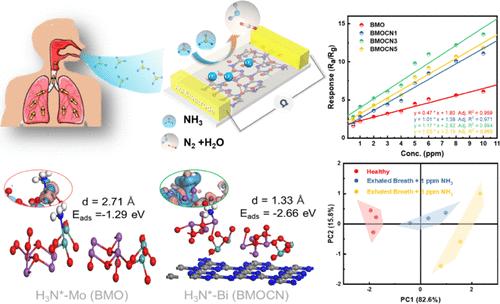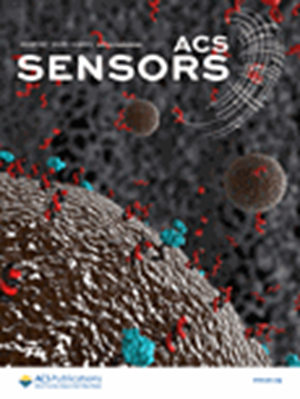Oxygen Vacancy Mediated-Bismuth Molybdate/Graphitic Carbon Nitride Type II Heterojunction Chemiresistor for Efficient NH3 Detection at Room Temperature
IF 9.1
1区 化学
Q1 CHEMISTRY, ANALYTICAL
引用次数: 0
Abstract
Metal oxide-based chemiresistive gas sensors are expected to play a significant role in assessing human health and evaluating food spoilage. However, the high operating temperature, insufficient limit of detection (LOD), and long response/recovery time restrict their broad application. Herein, 3D Bi2MoO6/2D Eg-C3N4 heterocomposites are developed for advanced NH3 gas sensors with RT operational mode. Utilizing the synergetic engineering of micro-nanostructure, surface oxygen vacancies, and well-defined Type II n–n heterojunctions, BMOCN3 demonstrated superior NH3 sensing properties at 23 °C, including the high response (S = 13.6 at 10 ppm), fast response/recovery speed (8/30 s), excellent selectivity, and low LOD (166 ppb). Based on the experimental, DFT, and MD studies, the improved sensing performance can be ascribed to accelerated charge transfer, superior redox capacity, and improved adsorption/desorption kinetics. Moreover, the practical application in rapid exhaled NH3 biomarker detection of the as-fabricated gas sensor was preliminarily verified. This work highlights that the novel synergetic engineering can effectively modulate the electronic structure and charge transfer, offering a rational solution for room temperature chemiresistive gas sensors.

氧空位介导的钼酸铋/石墨氮化碳II型异质结化学电阻器在室温下高效检测NH3
基于金属氧化物的化学气体传感器有望在评估人体健康和评估食品腐败方面发挥重要作用。但其工作温度高、检出限(LOD)不足、响应/恢复时间长等缺点限制了其广泛应用。为此,开发了用于RT工作模式的先进NH3气体传感器的3D Bi2MoO6/2D Eg-C3N4异质复合材料。利用微纳米结构、表面氧空位和明确的II型n-n异质结的协同工程,BMOCN3在23°C下表现出优异的NH3传感性能,包括高响应(10 ppm时S = 13.6)、快速响应/恢复速度(8/30 S)、出色的选择性和低LOD (166 ppb)。基于实验、DFT和MD研究,传感性能的提高可归因于加速的电荷转移、优越的氧化还原能力和改进的吸附/解吸动力学。初步验证了该气体传感器在快速呼出NH3生物标志物检测中的实际应用。本工作强调了新型协同工程可以有效地调节电子结构和电荷转移,为室温化学电阻式气体传感器提供了合理的解决方案。
本文章由计算机程序翻译,如有差异,请以英文原文为准。
求助全文
约1分钟内获得全文
求助全文
来源期刊

ACS Sensors
Chemical Engineering-Bioengineering
CiteScore
14.50
自引率
3.40%
发文量
372
期刊介绍:
ACS Sensors is a peer-reviewed research journal that focuses on the dissemination of new and original knowledge in the field of sensor science, particularly those that selectively sense chemical or biological species or processes. The journal covers a broad range of topics, including but not limited to biosensors, chemical sensors, gas sensors, intracellular sensors, single molecule sensors, cell chips, and microfluidic devices. It aims to publish articles that address conceptual advances in sensing technology applicable to various types of analytes or application papers that report on the use of existing sensing concepts in new ways or for new analytes.
 求助内容:
求助内容: 应助结果提醒方式:
应助结果提醒方式:


